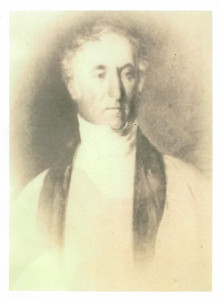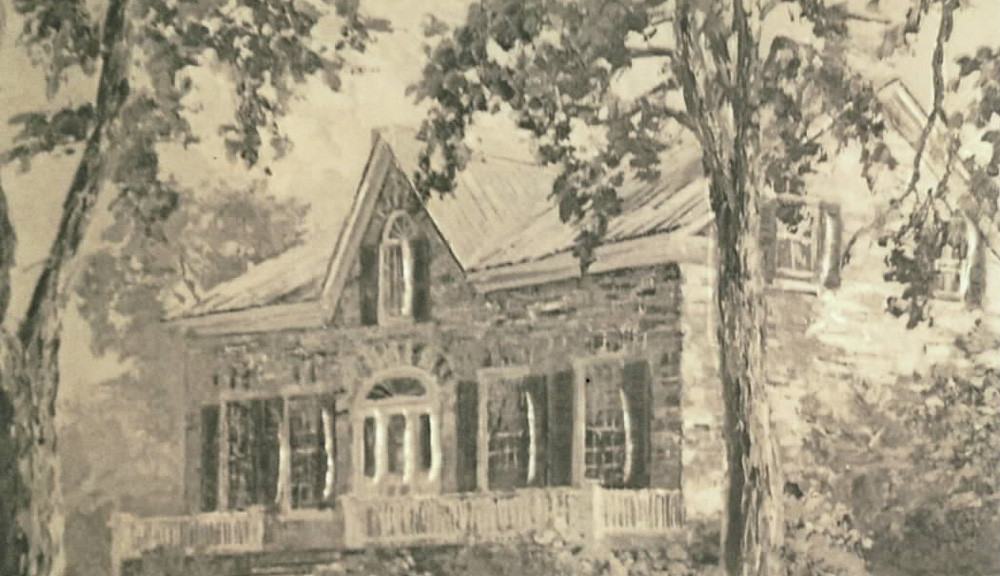Michael Harris was born into a distinguished family in Dublin, Ireland in 1795. Little is currently known of his younger years there.
Michael enlisted with the 100th (H.R.H. Prince Regent’s, County of Dublin) Regiment of Foot (later renumbered as the 99th). Michael was only ten years old when the regiment sailed from Ireland to British North America for garrison duty in the colonies. It is unclear at this time if Michael actually sailed with the regiment in 1805 because of his young age but it was not uncommon for young boys to enlist. (and an actual date of enlistment has not been found)
The 100th Regiment has been described as such:
“The men were principally raised in the north of Ireland, and are nearly all Protestants; they are robust, active and good looking.”

Michael Harris served as a private with the 100th Regiment during the War of 1812. He saw action on the Niagara frontier and took part in the capture of Fort Niagara in December 1813. Under the command of Colonel John Murray, the 100th (with other British regiments) crossed the Niagara River to the state of New York, sneaking through the dark of night towards the fort. The assault force was equipped with axes and ladders and ordered to use their bayonet when at all possible and not fire their guns or else they would alert the Americans stationed there. First they snuck up and captured the guards who were too busy trying to keep warm and not diligent guarding their territory. Next, they forced the password out of them, allowing the regiments to get even closer to the fort unannounced and unnoticed. They approached the fort and spoke the password like an American would and gained entry. The regiments rushed into the fort surprising the Americans. Those who did not surrender met their maker by way of the bayonet.
Almost 80 American soldiers were killed that night, 14 were wounded and taken prisoner, and another 344 were captured and taken prisoner. The regiments suffered six deaths and five soldiers wounded. Fort Niagara remained in the possession of the British until the end of the War of 1812.
Michael was also present at the Americans’ 1814 invasion which saw the 100th Regiment in the Battle of Chippawa in July, where they sustained heavy losses. The Americans had come across the British lines and at first light artillery fire was exchanged. Now knowing the exact position of the Americans the British crossed the Chippawa Creek and started sniping at them. But the Americans knew where the British were too and started advancing through the woods. The Americans opened fire with their cannons hitting the British ammunition wagon which eventually rendered most of their guns useless.
The 100th Regiment advanced over the uneven terrain finding it difficult to keep in their column and resorting to a line formation. They could not move as fast as they would have liked to and therefore were left in the Americans line of fire too long. They kept marching towards the enemy and when close enough, they fired their first volley. There was no time to fire a second because they were so close to the Americans they had no choice but immediately use their bayonets. The 100th did not have the luxury of artillery firing in the background because they would get hit by their own rounds. After almost a half hour of hand to hand combat and artillery fire from the American side, cannon balls landing everywhere, the Americans started closing in around the British who were now getting caught in crossfire. The British were ordered to retreat and when they did the Americans chased them almost back to the Chippawa Creek.
The losses were heavy on both sides. The Americans losing 60 soldiers had 249 men wounded and 19 missing. As for the British, the 100th Regiment alone was reduced to “…one Captain & 3 subalterns doing duty, with 250 effective men”, and from the many regiments that day, 535 soldiers were captured, missing and dead. There were also an unknown number of Indian Warriors who were not included in this last figure.
The British were pushed back even farther over the next couple of days, but lucky for them the Americans had no reinforcements. The British however were able to gain reinforcements during their retreat, fortifying themselves for the next battle that would occur at Lundy’s Lane.
Michael rose from private through the ranks to Major by the end of his military career. In 1815 he was promoted to a commissioned officer as an Ensign, and in November 1818 he was placed on half-pay, as the regiment was winding down, there appearing to be no more threat from the Americans.
After his regiment disbanded in 1818, Michael returned to Ireland to study for the priesthood, he being now only about 23 years old. Feeling confident in his cloth he sailed his way back to Canada, this time staying at Quebec City where he was ordained as a deacon by J. Mountain. His superiors sent the Major-Reverend to Perth, Ontario. On his way he stopped at Grimsby and married his Chippawa sweetheart Mary Fanning. She was a United Empire Loyalist tavern-keeper’s daughter.
Upon arriving at Perth, the couple settled in a little log house on Gore St. and Michael became the area’s first Anglican priest. The very first sermon Michael preached in Perth was in an upstairs room in the first Tavern built there, owned by Joshua Adams another War of 1812 soldier.
Michael and Mary had ten known children:
- Mary
- Clifton
- Caroline
- Harriet
- Jane
- John
- Robert
- Dora
- Michael
- Emma
One child died at birth. Two children died of scarlet fever. While many of his children grew up and married, at least two children married and moved Brockville.
For Michael’s military service he received at least three town lots totalling twelve acres in the village of Richmond, which is now part of Ottawa, Ontario, Canada. It is doubtful that he ever settled on them; possibly selling them to support his livelihood at Perth.
As a tireless and dedicated missionary, Michael’s contribution to Canada is that he ministered to the pioneers who settled in the outlying communities of Perth some as far away as the Ottawa River, and was responsible for the building of churches in Perth, Franktown, Balderson, and the village of Lanark. He taught school and was involved in local affairs.
Scheduled to preach in Balderson one Sunday Rev. Michael Harris realized he forgot his sermon back in Perth. Having not memorized it, he decided not to try to preach without it in case he finished too early and left his flock short. So he sent his driver all the way back to Perth to fetch it. It arrived in tact although a bit late.
In 1822 Michael received a grant of land from the Crown. The next year he began construction of a stone home in the military settlement of Perth (Bathurst Township, Lot 27 Conc 2, Block 1, 25 acres). The interpretative plaque installed there says he worked on behalf of the Society for the Propagation of the Gospel in Foreign Parts. The house still exists today, and is used as a museum (Ontario Heritage Foundation).
At the age of 37 Michael began construction on another house on Drummond Street in Perth and moved his family there. Harris Street is named for him.
Michael became the Rural Dean of Bathurst, Diocese of Toronto in 1850. He died six years later on September 25, 1856 after a brief illness. He was only 61 years old. His wife went to live with a daughter in Brockville and died there in 1864.
Sources
This application is supported by:
Perth Historical Society, Perth, Ontario, Canada (a not-for-profit community association documenting the history of the Town of Perth and local municipalities),
Royal Canadian Legion, Branch 244, Perth, Ontario, Canada,
Pam McGuigan, Harris family descendant.
Veteran Summary
Michael HarrisMajor, 100th (H.R.H. The Prince Regent's, County of Dublin) Regiment of Foot
Place of Birth
Unknown, County Dublin, Ireland
Place of Death
Perth, ON, CAN
Died on: 25 SEP 1856
Reason: Old Age
Location of Grave
The Old Burying Ground, Craig St
Perth, ON, CAN
Latitude: 44.899316N Longitude: -76.241926

